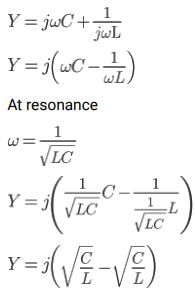Railways Exam > Railways Questions > The impedance of an ideal parallel LC circui...
Start Learning for Free
The impedance of an ideal parallel LC circuit at resonance is
- a)Infinite
- b)Zero
- c)1K ohms
- d)None of the above
Correct answer is option 'A'. Can you explain this answer?
Most Upvoted Answer
The impedance of an ideal parallel LC circuit at resonance isa)Infini...
Resonance in electric circuits is the phenomena, in which at a certain input voltage frequency the voltage and current drawn by the circuit are in phase.
In parallel resonant circuit at resonance frequency the impedance is maximum.
For parallel LC circuit

Y = 0
Since Y = 0 , Z = ∞
Free Test
FREE
| Start Free Test |
Community Answer
The impedance of an ideal parallel LC circuit at resonance isa)Infini...
Impedance of an ideal parallel LC circuit at resonance
At resonance, the impedance of an ideal parallel LC (inductor-capacitor) circuit becomes infinite. This is because at resonance, the reactance of the inductor and the capacitor cancel each other out, resulting in a purely resistive circuit.
Explanation:
1. Parallel LC Circuit:
A parallel LC circuit consists of an inductor (L) and a capacitor (C) connected in parallel. The inductor and capacitor have reactances that depend on the frequency of the input signal.
The reactance of an inductor is given by the formula: XL = 2πfL, where XL is the inductive reactance, f is the frequency, and L is the inductance.
The reactance of a capacitor is given by the formula: XC = 1/(2πfC), where XC is the capacitive reactance, f is the frequency, and C is the capacitance.
2. Impedance of Parallel LC Circuit:
The impedance of a parallel LC circuit is given by the formula: Z = 1 / (1/XL + 1/XC), where Z is the impedance, XL is the inductive reactance, and XC is the capacitive reactance.
3. Resonance:
Resonance occurs in an LC circuit when the reactances of the inductor and capacitor are equal in magnitude but opposite in sign. Mathematically, this can be expressed as XL = -XC.
At resonance, the impedance formula can be simplified as: Z = 1 / (1/XL - 1/XL), which simplifies to Z = ∞ (infinite).
4. Implication:
When the impedance of a parallel LC circuit is infinite at resonance, it means that the circuit behaves like an open circuit to the input signal. This implies that no current flows through the circuit, and all the input voltage is dropped across the components without any power being dissipated.
Summary:
In conclusion, the impedance of an ideal parallel LC circuit at resonance is infinite. This occurs when the reactances of the inductor and capacitor cancel each other out, resulting in a purely resistive circuit. At resonance, the circuit behaves like an open circuit, with no current flow and all the input voltage dropped across the components.
At resonance, the impedance of an ideal parallel LC (inductor-capacitor) circuit becomes infinite. This is because at resonance, the reactance of the inductor and the capacitor cancel each other out, resulting in a purely resistive circuit.
Explanation:
1. Parallel LC Circuit:
A parallel LC circuit consists of an inductor (L) and a capacitor (C) connected in parallel. The inductor and capacitor have reactances that depend on the frequency of the input signal.
The reactance of an inductor is given by the formula: XL = 2πfL, where XL is the inductive reactance, f is the frequency, and L is the inductance.
The reactance of a capacitor is given by the formula: XC = 1/(2πfC), where XC is the capacitive reactance, f is the frequency, and C is the capacitance.
2. Impedance of Parallel LC Circuit:
The impedance of a parallel LC circuit is given by the formula: Z = 1 / (1/XL + 1/XC), where Z is the impedance, XL is the inductive reactance, and XC is the capacitive reactance.
3. Resonance:
Resonance occurs in an LC circuit when the reactances of the inductor and capacitor are equal in magnitude but opposite in sign. Mathematically, this can be expressed as XL = -XC.
At resonance, the impedance formula can be simplified as: Z = 1 / (1/XL - 1/XL), which simplifies to Z = ∞ (infinite).
4. Implication:
When the impedance of a parallel LC circuit is infinite at resonance, it means that the circuit behaves like an open circuit to the input signal. This implies that no current flows through the circuit, and all the input voltage is dropped across the components without any power being dissipated.
Summary:
In conclusion, the impedance of an ideal parallel LC circuit at resonance is infinite. This occurs when the reactances of the inductor and capacitor cancel each other out, resulting in a purely resistive circuit. At resonance, the circuit behaves like an open circuit, with no current flow and all the input voltage dropped across the components.

|
Explore Courses for Railways exam
|

|
Similar Railways Doubts
The impedance of an ideal parallel LC circuit at resonance isa)Infiniteb)Zeroc)1K ohmsd)None of the aboveCorrect answer is option 'A'. Can you explain this answer?
Question Description
The impedance of an ideal parallel LC circuit at resonance isa)Infiniteb)Zeroc)1K ohmsd)None of the aboveCorrect answer is option 'A'. Can you explain this answer? for Railways 2025 is part of Railways preparation. The Question and answers have been prepared according to the Railways exam syllabus. Information about The impedance of an ideal parallel LC circuit at resonance isa)Infiniteb)Zeroc)1K ohmsd)None of the aboveCorrect answer is option 'A'. Can you explain this answer? covers all topics & solutions for Railways 2025 Exam. Find important definitions, questions, meanings, examples, exercises and tests below for The impedance of an ideal parallel LC circuit at resonance isa)Infiniteb)Zeroc)1K ohmsd)None of the aboveCorrect answer is option 'A'. Can you explain this answer?.
The impedance of an ideal parallel LC circuit at resonance isa)Infiniteb)Zeroc)1K ohmsd)None of the aboveCorrect answer is option 'A'. Can you explain this answer? for Railways 2025 is part of Railways preparation. The Question and answers have been prepared according to the Railways exam syllabus. Information about The impedance of an ideal parallel LC circuit at resonance isa)Infiniteb)Zeroc)1K ohmsd)None of the aboveCorrect answer is option 'A'. Can you explain this answer? covers all topics & solutions for Railways 2025 Exam. Find important definitions, questions, meanings, examples, exercises and tests below for The impedance of an ideal parallel LC circuit at resonance isa)Infiniteb)Zeroc)1K ohmsd)None of the aboveCorrect answer is option 'A'. Can you explain this answer?.
Solutions for The impedance of an ideal parallel LC circuit at resonance isa)Infiniteb)Zeroc)1K ohmsd)None of the aboveCorrect answer is option 'A'. Can you explain this answer? in English & in Hindi are available as part of our courses for Railways.
Download more important topics, notes, lectures and mock test series for Railways Exam by signing up for free.
Here you can find the meaning of The impedance of an ideal parallel LC circuit at resonance isa)Infiniteb)Zeroc)1K ohmsd)None of the aboveCorrect answer is option 'A'. Can you explain this answer? defined & explained in the simplest way possible. Besides giving the explanation of
The impedance of an ideal parallel LC circuit at resonance isa)Infiniteb)Zeroc)1K ohmsd)None of the aboveCorrect answer is option 'A'. Can you explain this answer?, a detailed solution for The impedance of an ideal parallel LC circuit at resonance isa)Infiniteb)Zeroc)1K ohmsd)None of the aboveCorrect answer is option 'A'. Can you explain this answer? has been provided alongside types of The impedance of an ideal parallel LC circuit at resonance isa)Infiniteb)Zeroc)1K ohmsd)None of the aboveCorrect answer is option 'A'. Can you explain this answer? theory, EduRev gives you an
ample number of questions to practice The impedance of an ideal parallel LC circuit at resonance isa)Infiniteb)Zeroc)1K ohmsd)None of the aboveCorrect answer is option 'A'. Can you explain this answer? tests, examples and also practice Railways tests.

|
Explore Courses for Railways exam
|

|
Signup for Free!
Signup to see your scores go up within 7 days! Learn & Practice with 1000+ FREE Notes, Videos & Tests.


























